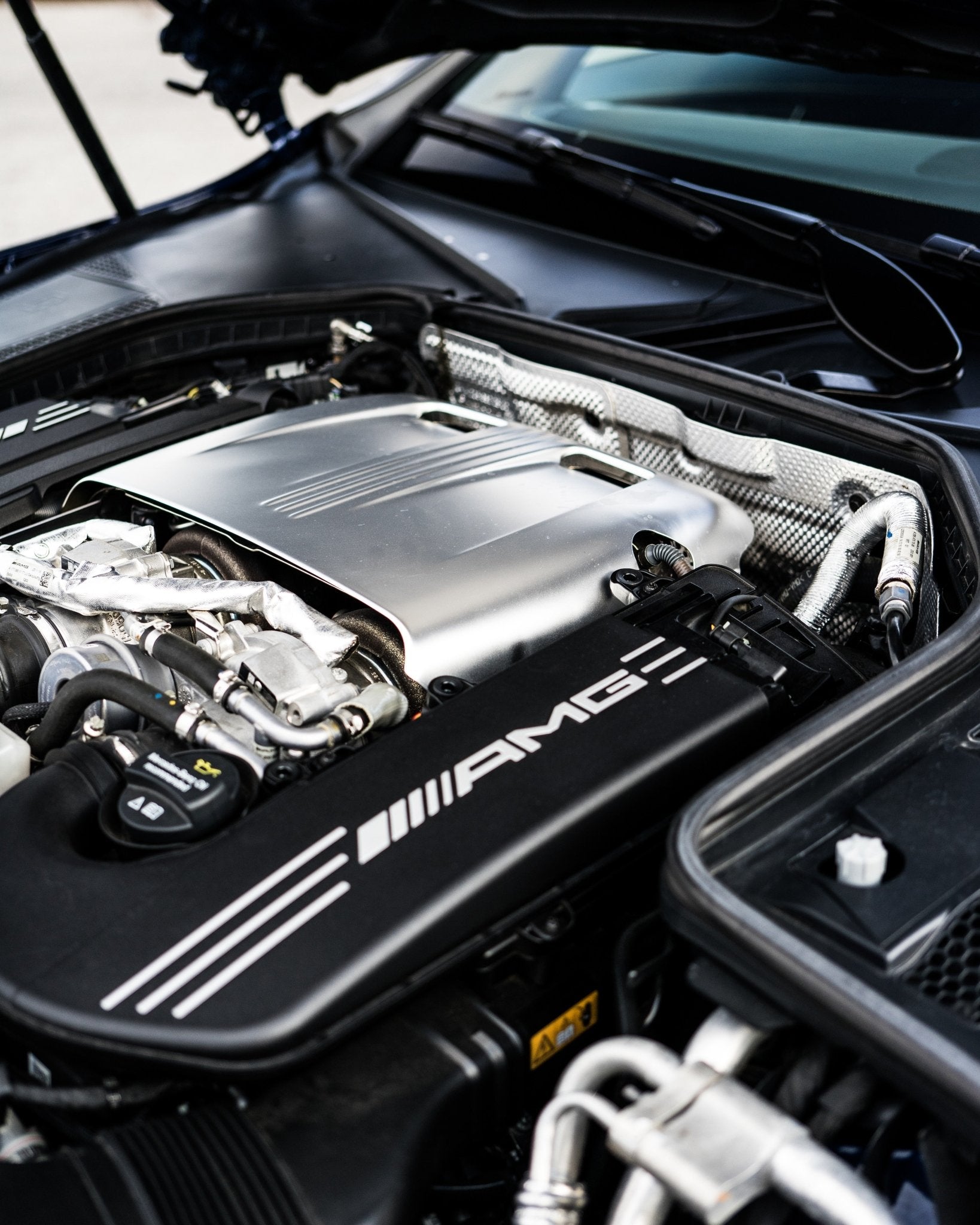4.6 Rating | 95% Recommend ⭐️⭐️⭐️⭐️⭐️

When to Replace Serpentine Belt to Keep Your Car Running Smoothly
The serpentine belt plays a crucial role in keeping your car running smoothly and ensuring you’re safe and comfortable every time you get behind the wheel. This one system powers your alternator, power steering pump air conditioning system, and much more.
So - it goes without saying that you don’t want to let it fail on you. But, how do you know when to replace your serpentine belt? You can say goodbye to any stress you’re feeling about this. The experts at Southwest Performance Parts are here to help with our complete guide on how to know when to replace serpentine belts.
In this article, you’ll discover the three ways to determine when to replace a serpentine belt:
- Following the manufacturer’s recommendations for replacement frequency
- Visual inspection of your serpentine belt on a routine schedule
- Listening for the warning signs of a failing serpentine system
Beyond that, we’ll empower you with tips on how to perform this project yourself when the time to replace your serpentine belt comes. It’s actually a lot easier and more affordable than you may have thought - especially with our guidance along the way!
But before we get into all that, let’s quickly touch on the importance of knowing when to replace your serpentine belt system.
Why Learning When to Replace Serpentine Belt Cannot be Overlooked
We recently wrote a complete guide on what happens to a car when the serpentine belt breaks. It’s definitely worth a read if you suspect your system may be on the verge of failing. Because as you’ll soon discover, this single system plays a profound role in keeping your vehicle on the road.
You see, the serpentine belt powers a multitude of key systems in your car. These include the alternator, the power steering pump, the air conditioning system, the water pump, and more.
All of this is to say that should you fail to replace your serpentine belt at the right time, things will start to go haywire. For example, you could lose power steering altogether. This creates not only an uncomfortable driving experience. But, it could also be borderline unsafe should you traverse a windy road with sharp turns.
There is also a costly risk associated with a failed serpentine system - engine overheating. Without a properly functioning water pump, a rapid rise in engine temperature is inevitable. This could result in expensive repairs down the road.
To make matters worse, you won’t have access to cool air, you may experience frustrating symptoms as a result of a failed alternator, and you’ll deal with declined fuel efficiency.
All of this is to say that knowing when to replace the serpentine belt is more important than you may have originally thought. So - how do you when to replace a serpentine belt? We’ll break it down for you below…
How to Know When to Replace Serpentine Belt
You’re now well aware of why how to know when to replace a serpentine belt is so important. And fortunately, this isn’t something that you need to stress about - it’s fairly straightforward.
There are 3 ways you can enjoy peace of mind knowing your system is in check at all times. The easiest? Simply following the replacement frequency guidelines set out by your vehicle or serpentine belts’ manufacturer.
Follow the Manufacturer’s Recommendations for Replacement Frequency
What causes a serpentine belt to break? Oftentimes, it’s nothing more than simple wear and tear as a result of age. Thus, one of the most reliable ways to know when to replace your serpentine belt is to follow your vehicle manufacturer's recommendations.
Typically, these guidelines can be found in your owner's manual and suggest a replacement interval in terms of mileage or time.
While these recommendations can vary greatly depending on how you drive your car, the quality of the system, and more, there is a general rule of thumb. We recommend that you replace your serpentine belt every 60,000 to 100,000 miles, or every four to six years.
Inspect Your Serpentine Belt Regularly
Of course, the manufacturer’s recommendations are merely suggestions. Thus, you should always set time aside from your busy schedule to inspect your belt. This can help you identify potential issues before they transform into major, costly problems.
We recommend checking your belt every 6 to 12 months or during routine oil changes. Look for signs of wear, such as cracking, fraying, glazing, or missing ribs. If you notice any of these issues, it's time to consider a replacement. By being proactive with your inspections, you can avoid the stress and frustration of a sudden breakdown.
Watch & Listen for Warning Signs of a Failing System
Beyond visual inspection of the belt, you can watch and listen for preliminary warning signs of a failing system. Your vehicle may give you subtle hints when the serpentine belt is reaching the end of its life.
Pay attention to any changes in your engine's performance or sounds, such as squealing or chirping noises when starting or accelerating, reduced power steering efficiency, or issues with your air conditioning system. These warning signs should not be ignored, as they could indicate a failing serpentine belt, which could lead to more severe consequences if left unaddressed.
When the Time Comes to Replace Serpentine Belt, You Can Trust Southwest Performance Parts!
There you have it - Now that you know when to replace serpentine belt systems, you can feel confident keeping a regular maintenance schedule for this crucial component. It’s likely that you’ll only have to worry about this once over the span of your vehicle’s life - unless you drive it from brand new to 200,000+ miles.
Before we bring this conversation to a close, we want to provide you with some advice on how to actually make this replacement when the time comes. You can go to the dealership or find a mechanic to handle it for you - or, you can save yourself a ton of money through a simple DIY repair. With the help of Southwest Performance Parts, it’s a lot easier than you may imagine…
Why Shop With Us for Serpentine Systems?
Over the past 20 years, we’ve come to be known as the premier provider of high-performance auto parts online. We take pride in offering high-performance serpentine belt kits that are designed to meet or exceed OEM specifications.
Our belts are manufactured with durability, efficiency, and longevity in mind, so you can trust that you're investing in a product that will serve you well for years to come. But, the best part of our high-performance serpentine belt kits is that you get increased quality at a lower price.
How is this possible? Well, we manufacture all our parts ourselves under the A-Team brand that many car enthusiasts have come to know and love. By selling these parts directly to you here in our storefront, we have managed to cut out the middlemen - and with them, all their unnecessary costs.
That’s not all, either. We back it all up with world-class customer support every step of the way. Whether you’re not sure which system is right for you or you’d like to learn more about the replacement process, you can count on us. And below, we’ll help you navigate this stress-free job yourself to save money and get back on the road fast.
Tips for Performing the Stress-Free Job Yourself to Save Money
Replacing your serpentine belt can be a straightforward and rewarding DIY project that allows you to save money on labor costs without compromising on quality. Here are some steps to guide you through the process:
- Gather the necessary tools and materials, such as a socket wrench, breaker bar, and your new serpentine belt kit from Southwest Performance Parts. No matter what you drive, we have the kit you need. That includes SBC serpentine belts, SBF serpentine belts, LS serpentine kits, BBC serpentine kits, and BBF serpentine kits.
- Consult your vehicle's owner's manual or a repair guide to locate the serpentine belt and tensioner. Note the belt routing diagram to ensure proper reinstallation. You can feel more confident making this repair by finding a step-by-step tutorial on your specific make and model.
- Carefully release the tension on the belt by rotating the tensioner pulley with a breaker bar or socket wrench. Be sure to apply pressure slowly and gently to avoid damaging the tensioner.
- Once the tension is released, carefully remove the old belt from the pulleys, taking note of its routing for reference.
- Compare your new belt with the old one to ensure the correct size and type. Then, following the belt routing diagram, install the new belt onto the pulleys.
- Reapply the serpentine belt tension by rotating the tensioner pulley until the belt is properly seated and secure.
- Double-check the belt's alignment and tension, making sure it is correctly seated on all pulleys.
- Start your engine and observe the new belt's operation to ensure smooth and quiet performance.
See - that’s not so bad, is it? And remember - we’re a live chat or phone call away ready to provide more context if necessary. All the more reason to shop with us when the time to replace a serpentine belt comes!
Wrapping Up Our Guide on When to Replace Serpentine Belt
Hopefully, this guide on when to replace serpentine belt helps you maintain a proper maintenance schedule for this crucial component in your vehicle.
Otherwise, you run the risk of losing power steering, air conditioning, or vehicle power altogether. Plus, your engine is at a heightened risk of overheating without a properly functioning serpentine belt.
But, you are now fully aware of how to know when to replace serpentine belt systems. The only question now is - are you due for a replacement? If so, head over to Southwest Performance Parts and find the right kit for your unique make and model. Then, get the repair made so you can get back to the open road with confidence!


